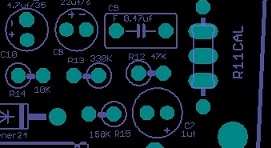I've been playing around with my new mic for a few days now.
First impressions - using a 470k resistor for the custom low cut (see above) is just right. It's much closer to a typical low cut. Tonally the mic seems very 'vintage', perhaps a little too much for my taste - I'd like it to sound a little less compressed, and maybe a little more open at the top end.
My experiments with changing various things [component choices were in some part motivated by what I had to hand].
C7 - an obvious place to start. Changed to a 1uF/100v Vishay MKT1813. There isn't much space between the boards, so I mounted it on top of the other components, connecting the other end to TRFO-1. Result: not as radical as some people seem to claim, but it does a lot to alleviate some of the compressed feel to the sound.
C6 - The subject of much debate, some people remove it altogether. I replaced it with a Wima 100pF/100v film cap. But see my Edit 2 below.
C8 - replaced with a Vishay 22uF/50v electrolytic. Added a Wima MKS2 100nF/100v in parallel on the back of the board (fits nicely in the unused holes for R11).
I did these changes as a package - this isn't clever in terms of assessing their effect, but with C6 removed, it's much easier to bend down C10 to get to C8 - otherwise it's really fiddly. Result: the mic seems notably softer and smoother in its tone. The top end is hard to assess because I'm only recording my own (fairly deep) voice, but there seems to be a difference there too. Overall it's definitely more pleasing. Worth doing? YES! [see Edit 2 below]
C4 - I know there's an argument that says this doesn't do anything so just pull it. I'm more persuaded by the school of thought that says increase it so that any phase effects get pushed even lower. I replaced it with a polystyrene 1nF/160v cap. Result: Couldn't hear any difference.
I'm not a producer or sound engineer and this is largely a matter of taste, but it may help someone else thinking about experimenting with component choices.
Edit: Just to be clear, my original build was tants and styros, mic-parts RK87 capsule and Cinemag 2480. All the changes to the sound were quite subtle, it's unmistakably the same mic. I'd say it's very much 'vintage but nicer'. If you want something more radical then experiment with removing C9 - I'm personally not interested in that sort of change. All IMHO of course...
Edit 2: I was definitely too hasty in my assessment of the C6 mod! Listening to the mic today, it introduced a lot of nasty sibilance that I wasn't hearing yesterday. It definitely affects the top end a lot. I just don't have producers' ears so it takes me a while to notice these things! I've done some reading on this, and especially looked at Matador's U87 de-emphasis graph that he posted on another thread. I've experimented with other values, both higher and lower than 220pF. It's interesting to try higher values for a nice dark mic! I've now returned to the stock value using a Wima 220pF FKP2 cap. Having experimented, I think this is the best overall choice; it makes for a balanced mic that's easy to EQ. I'm sure the folks at Neumann knew what they were doing!
Conclusion - I'd definitely recommend trying alternative capacitor types for C7 and C8. For the others I'm less convinced that there's much scope for improvement - not surprising given the pedigree of the design. But most of all: experiment and have fun...


